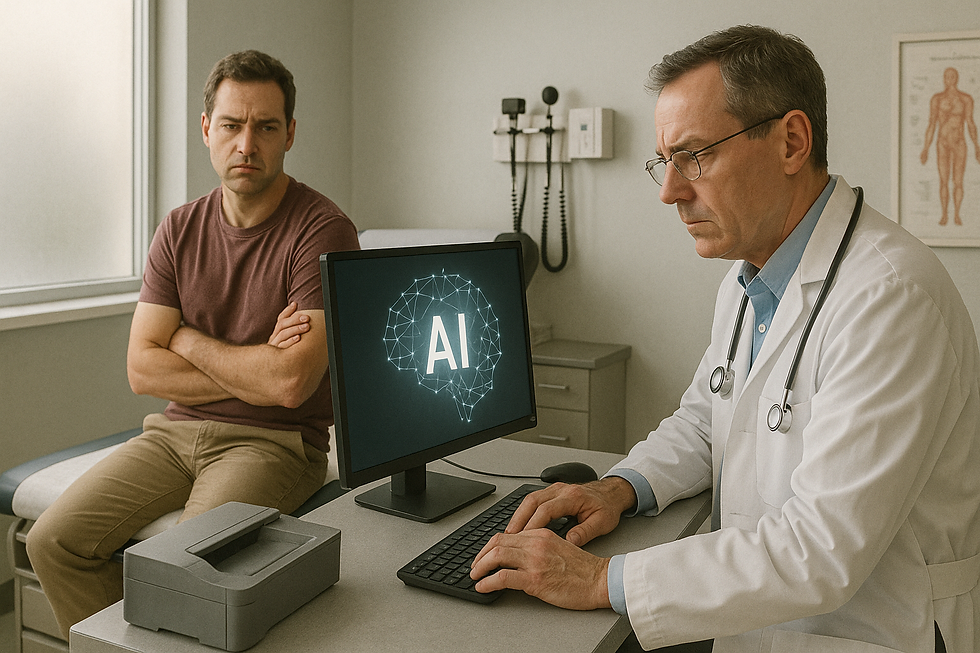The Digital Cliff: Could a Lack of Trust Derail AI in Health Care? (Part 2 of 3)
- CROSS Global Research & Strategy,LLC

- Aug 14, 2025
- 3 min read
Updated: Sep 29, 2025
AI’s potential in medicine is enormous, but without trust, it risks deepening the divide between technology and the people it is meant to serve.
Author: Dr. Shakira J. Grant
Date: August 14, 2025
She sat quietly, remembering the 30 days she had waited for this appointment, the time off work, the three-hour drive, and the anticipation of finally being heard. Instead of a warm greeting, she was met with a kiosk that sent her to a chatbot. The conversation that should have begun with a smile started with a screen.
Then came the real blow. For the first 15 minutes of her hard-earned appointment, her physician wrestled with a new AI program, eyes fixed on the monitor instead of her. The technology meant to help him ended up stealing their time together. It was more than an inconvenience. It chipped away at the trust she had in her doctor and in the system itself. And in the quiet that followed, one question lingered: who was this AI really there for?

This was not an isolated misstep. It was a symptom of a much larger problem, a growing gap between the promise of AI and the reality of its use in clinics. In Part 1, we referred to it as the “clinical chasm.” That chasm is now being widened by something deeper than skepticism, a lack of readiness. The idea that AI can transition seamlessly from the lab to the bedside is an illusion. Without deliberate planning, providers and patients will be left stranded at the edge of the digital cliff.
Trust Isn’t Optional; It’s the Blueprint
The question is no longer if AI will be part of health care, but how it will be used in ways that strengthen human connection rather than weaken it. This shift is not just about training clinicians on a new tool; it is also about empowering them to utilize it effectively. It is about rethinking how health care systems adopt technology from the start.
The numbers tell the story. In a recent AMA survey, nearly half of physicians (47 percent) said that the single most important step to earning their trust in AI tools was increased oversight. Trust is built when there is both accountability and innovation.
A systematic review of barriers to AI adoption in health care found the biggest hurdles were not purely technical. They were ethical, social, and logistical. When human-centered design is missing, even the most sophisticated tool can fail before it is fully used. The appointment in the opening story was not a technical glitch. It was a design failure that forgot the human in this case a patient at the center.
The Clock Is Ticking on AI’s Trust Problem
Health care is at a crossroads. On one side, technology is advancing at breakneck speed. On the other hand, the trust gap is widening. If we do not bridge that gap now, AI could become another layer of friction in patient care rather than the bridge it is meant to be.
Trust cannot be treated as an afterthought. It must be measured, built, and sustained from the start. The stakes are not abstract. They are as real as a patient’s missed opportunity for care.
From One-Way Training to True Collaboration
Avoiding the digital cliff will take more than software rollouts and standard training sessions. It will require co-creation, where developers, clinicians, patients, and administrators collaborate to test, refine, and adapt tools before they are deployed. Education must be a two-way exchange, where feedback is not a courtesy but a requirement.
Picture a hospital piloting an AI diagnostic tool with real clinical teams, from nurses to physicians to patient advocates, offering feedback in real time. Adjustments would be made based on what actually happens in the exam room, not in a product demo. That is how trust is earned.
AI in health care is not just software. It is an intervention. Like any intervention, it must be tested, understood, and trusted before it becomes part of the care process.
Coming in Part 3: We will explore how to build community-led AI education from the ground up, including how to identify the right voices, structure meaningful conversations, and create an environment where feedback shapes the tools designed to serve us all.
Want to stay on top of the latest insights in health care AI? Join our community to receive updates on our blog series and other resources.
Image Credits
Text to image generated by ChatGPT (Sora), August 14, 2025, OpenAI, https://chat.openai.com

Comments